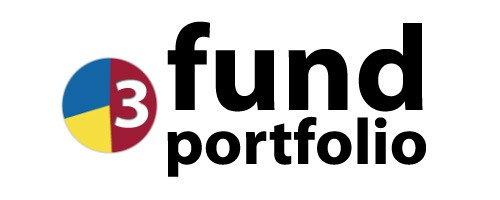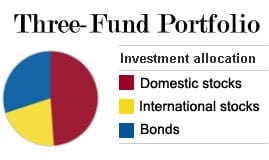When it comes to investing, I know myself well enough to know that it pays to keep things simple. When I first start out researching possible investments, I’m gung-ho about the whole thing, and I stay pretty involved in the process. As time goes on, however, I tend to be less and less interested in staying on top of things. Unless I keep things simple, my portfolio suffers.
Because of that I’m a big fan of options where you can do relatively simple set it and forget it type investing transactions. Sites like Betterment.com, where you can invest automatically and have your money diversified and re-allocated on a regular basis, fit my mindset perfectly.
If you want to have a simple, low cost investing strategy, there are other options. Some of them can be more cost effective as well. For example, what I’m going to talk about today, the three-fund portfolio.
It’s a theory where you invest in the fundamental asset classes, stocks and bonds, and usually do so in total stock market index funds and bond funds. The idea is popular on investing boards like the Bogleheads Forum, who are proponents of Bogleheads investing philosophy, and deserves some further exploration.
Quick Navigation
John C. Bogle Investing Strategies
The Three Fund Portfolio theory is based off of and popularized on the ideas of people like John C. Bogle, the founder and retired CEO of Vanguard Group, one of the best low cost mutual fund companies out there today. Bogle’s investing ideas are based on a foundation of simplicity, and not trying to outsmart the markets, but instead buying index funds to keep costs low and keeping them for the long term. Here are his 8 basic rules for investing from his Wikipedia page:
- Select low-cost index funds
- Consider carefully the added costs of advice
- Do not overrate past fund performance
- Use past performance to determine consistency and risk
- Beware of stars (as in, star mutual fund managers)
- Beware of asset size
- Don’t own too many funds
- Buy your fund portfolio – and hold it
As you can see, he believes in keeping costs low (either via direct fund costs, or costs of professional fund managers), and in making sure that you keep things simple by not buying too many funds, and not trying to outsmart the markets. With that foundation in mind, let’s move on to talking about a three-fund portfolio.
The Three Fund Portfolio
Three-fund portfolios create a simple portfolio that gives you complete coverage in the fundamental asset classes – stocks and bonds. Cash isn’t usually included in an investment portfolio, so that would not be one of the fundamental assets included for this discussion.
So within the stocks and bonds held in a three-fund portfolio, you would also want to make sure you have invested in both domestic and international stocks.
So once you have decided to invest in a three-fund portfolio – domestic stocks, international stocks, and bonds – you’ll want to figure out how much of each to hold in your portfolio (depending on your risk tolerance/retirement horizon/etc). Once you figure an asset allocation, you’ll need to figure out where and in what funds to hold those asset classes to ensure the lowest cost and best diversification.
Choosing Investment Asset Allocations
One of the first things you must do in your three-fund portfolio is decide what your asset allocation will be in your investment holdings. Are you going to be more aggressive, and hold more stocks, or do you value the safety of your investment more, and lean more towards lower yield, but higher safety bonds?
How To Figure Your Asset Allocation – Stocks VS. Bonds
What are some ways to go about figuring out what asset allocation you should use? Here are a couple of methods to think about:
- Age in bonds: One rule of thumb used by a lot of folks is to hold their age in bonds, in other words if you are 30 years old you should hold 30% in bonds. So you figure out your percentage of stocks by starting at 100% and subtracting age. (100 – age)
- Twice your maximum tolerable loss: Another method suggested is to figure out what the biggest percentage loss you could bear to see in your portfolio without causing too much worry and abandoning of your plan, and then set your stock allocation at twice your maximum tolerable loss. So if your max loss would be 25%, then you shouldn’t be investing more than 50% in stocks.
From what I understand both of these methods will lead to percentages of stocks that are pretty conservative, and will actually be lower than amount of stocks held in, for example, a target retirement date fund from Vanguard. What it comes down to, however, is you have to figure out what your personal risk tolerance is, what your retirement time horizon is, and adjust your percentages accordingly.
Asset Allocation – Domestic VS. International Stocks
After figuring out how much you want to hold in stocks versus bonds, you’ll need to set a percentage allocation for domestic versus international stocks. Domestic and international stocks have similar long term risk and returns, so setting this percentage isn’t as crucial as stocks and bond percentages. Currently, however, Vanguard suggests 20% – 40% international allocations in a portfolio, and currently their target retirement series of funds hold 30% international. Again, it comes down to how much international weighting you want to give your portfolio.
Three-Fund Portfolio Recommendation
If you want to get some recommendations of funds to choose, along with how to weight your three-fund portfolio, check out this calculator found at Vanguard, which will give you suggestions of funds to choose, and how much to allocate based on your answers to a simple questionnaire.
What Investments To Choose
After you’ve chosen your asset allocation and your domestic versus international weighting for your portfolio, you need to figure out what funds to buy and where to buy them.
My personal recommendation is to go with Vanguard because they have some of the best low cost funds available, and you can buy in at relatively low amounts as compared to some other companies.
On the Bogleheads forum, they suggest the following from the core funds at Vanguard as the best funds for a three-fund portfolio.
- Vanguard Total Stock Market Index Fund (VTSMX)
- Vanguard Total International Stock Index Fund (VGTSX)
- Vanguard Total Bond Market Fund (VBMFX)
Of course Vanguard isn’t the only option out there, and plenty of funds at other companies will make good options for a three-fund portfolio as well. The idea is just to make sure that you are investing in low expense ratio index mutual funds or ETFs. Here’s another example with funds found at Fidelity:
- Fidelity Spartan Total Market Index Fund (FSTMX)
- Fidelity Spartan International Index Fund (FSIIX) or, perhaps, their soon-to-be-available Fidelity Spartan Global ex-U.S. Index
- Fidelity Spartan U. S. Bond Index Fund (FBIDX)
For more examples of three-fund portfolios at other mutual fund companies, check out this post on three-fund portfolios.
Three-Fund Portfolios: Keep It Simple And Low Cost
Three-fund portfolios are a great way for investors to keep their investments simple, low cost and diversified across both domestic and international markets. While it’s important to make sure that you match your risk tolerance to your percentages of stocks and bonds that you hold, having a simplified portfolio like this in major index funds will ensure that your costs are low and your returns are maximized in the long run.
Have you invested with a strategy similar to a three-fund portfolio? Tell us what your strategy is in the comments!




Interesting and hard to argue. In fact when my 24 year old daughter started her first job I suggested the three Vanguard index funds you mentioned for her 403(b), in her case primarily skewed to the equity side. I suggested to her that she put as much away as she could in that mix and review for rebalancing twice per year. I suggested we should revisit after ten years to see if the mix needed to be changed.